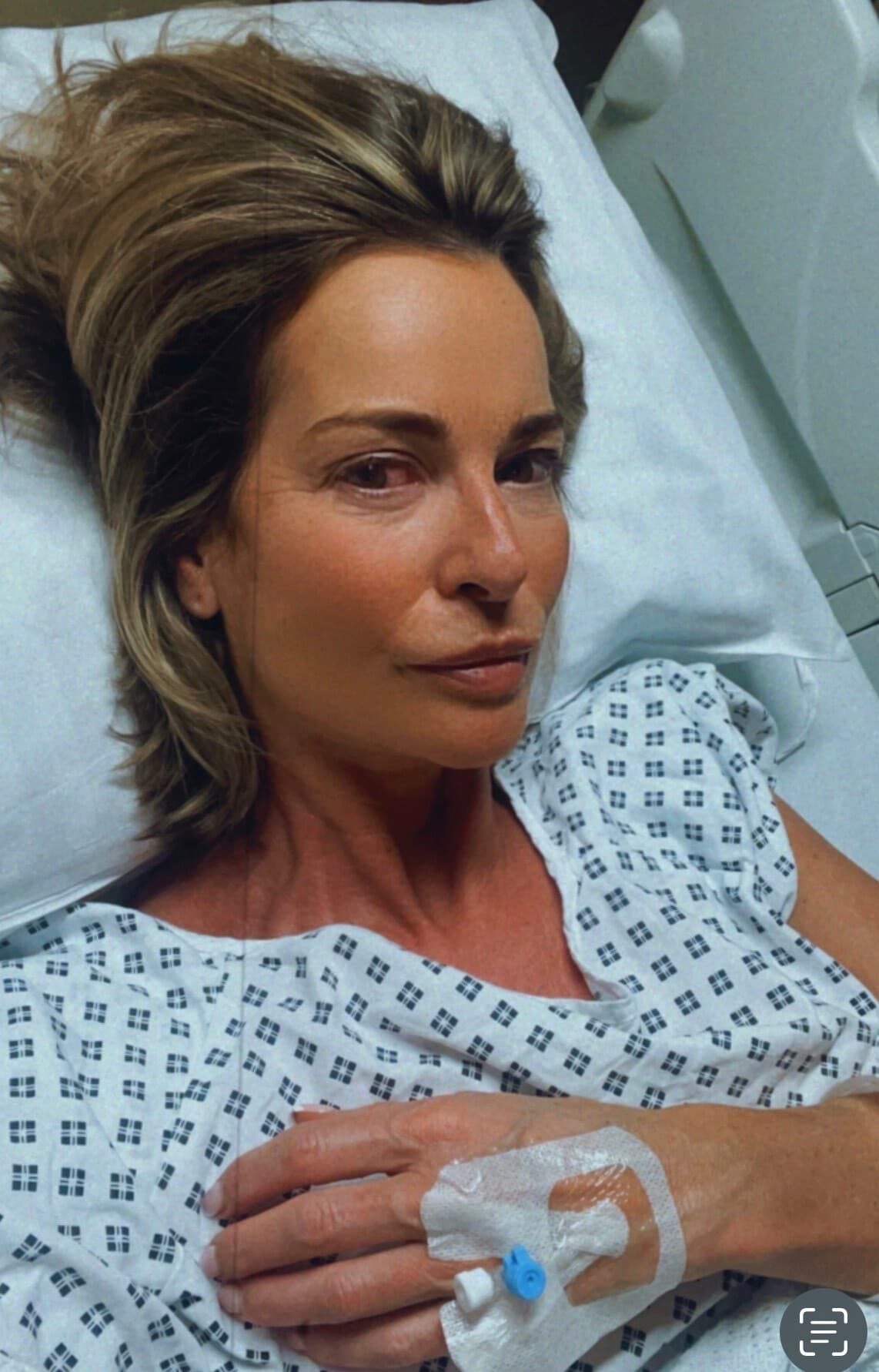Hi, I'm Keeley...

Hi, I’m Keeley a 53-year-old ex-fashion model and stylist, wife, mother and grandmother, an active, social human being with a love for yoga & travelling the world.
I was totally embarrassed by all the symptoms and tried hard to cover them up
History of Ill-health
I’d been unwell for 10 years with flares of ill health; experiencing awful headaches, neck, shoulders and body aches with bouts of sinus tachycardia. Seven years ago, I was diagnosed with fibromyalgia. Two years ago, I became unwell with the same aches and pains that I’ve been suffering with for years, but this time I knew there was something so wrong!
I woke with the most horrendous headache in the base of my skull, neck and shoulders. I had blurred vision, my eyes were bright red and painful, and no pain relief would ease it. Not knowing what to do with myself, I ended up being admitted to our local hospital for three days, where I was told that it was a typical autoimmune headache. I was trialled on Hydroxychloroquine which I took for two years, to no avail.
While in hospital, I remembered that a few weeks before I had started to notice a cognitive decline. The way I was holding a pen and my writing had changed, I couldn’t read or follow instructions. My speech was delayed, and my voice would go faint. I couldn’t find words which was unlike me and rang alarm bells. I started asking myself why? Looking in the mirror I thought,” Who is that looking back at me?”
My balance became really bad, sometimes having to come downstairs on my bottom; and my brain fog was awful. I was totally embarrassed by all the symptoms and tried hard to cover them up. I felt lost and so alone!
New Symptoms
My GP thought it was my menopause, but I thought it couldn’t be. I had a total Hysterectomy when I was 32 and have been on HRT ever since. Eventually I was sent for an MRI, and it showed spondylosis, which is degenerative spine wear and tear that is normal at my age. I was referred to an orthopaedic specialist who recommended cortisone injections under general anaesthetic for the pain. Afterward, it was obvious to me that it hadn’t worked as my symptoms got worse!
New symptoms started, an overwhelming whooshing noise in my head, along with popping candy noises in my ears that were worse when lying down; all very bizarre. I noticed my hands would tremor when trying to eat and drink. I told no one, but thought I had Parkinson’s or motor neurone disease. I thought I was going mad and felt trapped and alone. My anxiety was awful then depression set in with dark thoughts of what was happening to me.
Telling family and friends what’s happening to your body, the symptoms and the feeling that you're going crazy, is so difficult when no one can really understand.
Getting the Diagnosis at last!

On hearing my new symptoms, the orthopaedic doctor referred me to a neurologist who specialises in headaches and thank goodness he did!
The neurologist greeted me with a smile. I explained everything and thought he’d think I was a crazy neurotic woman. After some neurological examinations he said, “Well you don’t have Parkinson’s disease. I imagine that’s what you were thinking right? Because of the tremor and neurological symptoms?”, “Yes” I replied, with tears in my eyes.
He then told me he thought it was a CSF leak. He explained the fluid surrounding the brain leaks somewhere, so fluid isn’t going to the brain. I was speechless. I had gone alone to the appointment as there were still Covid restrictions in place and just wished there was someone else with me as I couldn’t take everything in.
He said I needed an MRI with a venogram, angiogram and with contrast done asap! I was filled with a bittersweet feeling of fear and elation that I wasn’t going mad.
As predicted, the MRI showed signs that there was a leak somewhere. My brain had complete brain sag, and this was the reason for so many neurological symptoms. I also had three subdural bleeds and an enlarged pituitary gland.
The Road to Treatment...

I will be forever grateful to my neurologist, who then worked with the CSF team at Kings College alongside a neuroradiologist who has a great interest in CSF leaks.
The neuroradiologist explained I was very unwell and had complete brain sag causing all my symptoms. She then asked if I had suffered any incontinence. I was taken aback by this question and began to cry because I had been suffering in silence for four months.
She held my hand, telling me it was OK. Her next question was, “Has anyone diagnosed you with fibromyalgia?”. My answer was yes. She replied, “You haven’t got fibromyalgia, it’s the CSF leak. We are going to try to fix you, firstly with a less invasive method. We will start with a blood patch.”
The exact site of my CSF leak was unknown, so the blood patch procedure used 70ml of my own blood, injected into my spine at two locations. The spinal needles were guided by CT during the procedure. This is not a pleasant experience, but I lay completely still, just praying it would fix me.
Unfortunately, after bed rest, I only had 5 days of relief. I was back to square one.
Several weeks later, another double blood patch was performed and this time, I had a few weeks of relief. I guess each time I gained a little more brain pressure, but I was still suffering terribly.
I then had a myelogram in November 2022, and the leak was seen in the T8 thoracic area of my spine. The neuroradiologist explained that it was a lateral leak, which is rare. It could be fixed with surgery, but she wanted to try a fibrin glue patch first.
The fibrin glue patch day arrived and the neuroradiologist was determined to pinpoint the exact location of the leak, so she performed another myelogram in the T8 area. During the procedure she said to me, “You won’t want to hear this, but I’ve just caught the most amazing imaging of your leak squirting!” After the fibrin glue patch procedure, she showed me and my husband the imaging. It was quite unbelievable that this was what had caused all the trauma and multiple neurological symptoms in my body.
Unfortunately, this didn’t work for me either. I needed surgery.
In February 2023 a neurosurgeon who is part of the CSF multidisciplinary team at Kings (also another lovely doctor!) performed my surgery. I felt lucky to have this great team working on me.
I’m now 10 weeks post-surgery. I still have popping candy noises occasionally in my ears and little whooshing noises here and there, but not constantly and I’m still experiencing blurred vision. My neurologist has explained this is due to my new brain pressure. My brain had been at such low pressure for such a long time. His words were, “You haven’t had your adenoids out and fixed. This is 14-month recovery. Basically, it’s a brain injury, so it’s a slow process and will take time for the symptoms to rectify”.
I was an independent positive person, and I will be again.
Recovery and Awareness

I may not be the woman I was prior to this illness but I will do my best for her to return! The rollercoaster recovery journey continues and I’m trying to keep my positive head on while going through it. It’s still early days, and everyone’s journey is different.
I feel like I’ve been trapped in my own body and lost for the past couple of years, and now I’m healing, and certain cognitive skills are coming back. I’m able to explain the darkness I’ve been living in. It has been a very painful, emotional, and often lonely dark place filled with life changing and challenging symptoms.
My husband has said, “Why are you looking back?” and that I should be looking forward. But it’s a grieving process that no one understands unless they have experienced it. The neuroradiologist said that most patients in similar circumstances to mine have the possibility of developing PTSD.
I was an independent positive person, and I will be again. Although some say you never go back fully to the person you were before this illness.
I want to raise awareness of this awful, life changing and challenging rare condition. GPs and general doctors on the frontline of A&E don’t recognise the symptoms and I’m sure there are a lot more people like me that are undiagnosed or misdiagnosed out there. They need the right specialist and the right treatment.
My greatest saying has always been, never judge a book by its cover and it’s so true. Many people have judged me during my illness, and I’ve had people say, “Is she really ill? She looks okay to me!”
This condition is an invisible illness and others can’t see what you are going through. My neurologist said to my husband, “Your wife looks like she’s a healthy woman, but I can assure you, she’s not. Because of the evidence in her imaging, we know how sick she really is”.
You can follow my journey on Instagram @kiki_csf_journey
I really want to raise awareness of this rare and awful condition.
